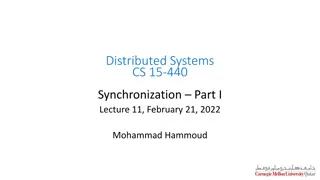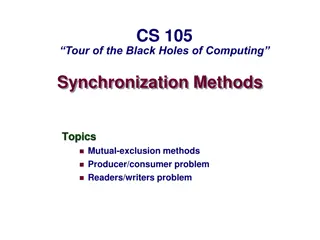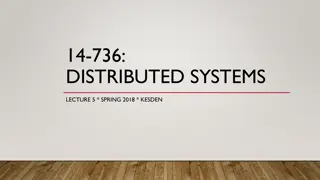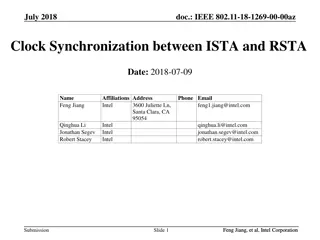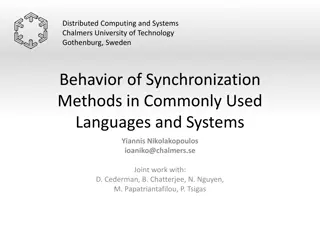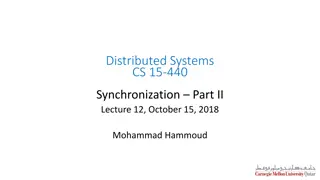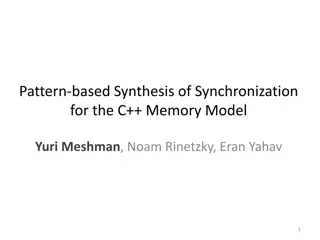
Understanding Synchronization Primitives in Concurrent Programming
Explore the dangers of sharing without synchronization in concurrent programming, focusing on hardware primitives to prevent issues like race conditions and deadlocks. Learn how interleaving can lead to bugs and unpredictable outcomes in multithreaded environments. Discover solutions to ensure thread safety in C++ programming.
Download Presentation

Please find below an Image/Link to download the presentation.
The content on the website is provided AS IS for your information and personal use only. It may not be sold, licensed, or shared on other websites without obtaining consent from the author. If you encounter any issues during the download, it is possible that the publisher has removed the file from their server.
You are allowed to download the files provided on this website for personal or commercial use, subject to the condition that they are used lawfully. All files are the property of their respective owners.
The content on the website is provided AS IS for your information and personal use only. It may not be sold, licensed, or shared on other websites without obtaining consent from the author.
E N D
Presentation Transcript
Professor Ken Birman CS4414 Lecture 15 SYNCHRONIZATION PRIMITIVES CORNELL CS4414 - SPRING 2023 1
IDEA MAP FOR MULTIPLE LECTURES! Reminder: Thread Concept C++ mutex objects. Atomic data types. Lightweight vs. Heavyweight Race Conditions, Deadlocks, Livelocks Thread context and scheduling Today: Focus on the danger of sharing without synchronization and the hardware primitives we use to solve this. CORNELL CS4414 - SPRING 2023 2
WITH CONCURRENT THREADS, SOME SHARING IS USUALLY NECESSARY Suppose that threads A and B are sharing an integer counter. What could go wrong? We saw this example briefly in an early lecture. A and B both simultaneously try to increment counter. But increment occurs in steps: load the counter, add one, save it back. they conflict, and we lose one of the counting events. CORNELL CS4414 - SPRING 2023 3
THREADS A AND B SHARE A COUNTER Thread A: Thread B: movq counter,%rax addq $1,%rax movq %rax,counter movq counter,%rax addq $1,%rax movq %rax,counter counter++; counter++; Either context switching or NUMA concurrency could cause these instruction sequences to interleave! CORNELL CS4414 - SPRING 2023 4
EXAMPLE: COUNTER IS INITIALLY 16, AND BOTH A AND B TRY TO INCREMENT IT. What A does The problem is that A and B have their own private copies of the counter in %rax %rax 16 (push) 16 17 17 (pop) 17 17 movq counter,%rax What B does movq counter,%rax addq $1,%rax movq %rax,counter With pthreads, each has a private set of registers: a private %rax addq $1,%rax movq %rax,counter With lightweight threads, context switching saved A s copy while B ran, but then reloaded A s context, which included %rax CORNELL CS4414 - SPRING 2023 5
THIS INTERLEAVING CAUSES A BUG! If we increment 16 twice, the answer should be 18. If the answer is shown as 17, all sorts of problems can result. Worse, the schedule is unpredictable. This kind of bug could come and go CORNELL CS4414 - SPRING 2023 6
STL REQUIREMENT Suppose you are using the C++ std library (the STL): No lock is needed when accessing different objects Methods of a single object can simultaneously be called by arbitrarily many read-only threads. No locks are needed. But only a single active writer is permitted (this also excludes active readers). You must protect against having multiple writers or a mix of readers and writers concurrently accessing the same object. CORNELL CS4414 - SPRING 2023 7
BOOST: READ DOCUMENTATION! Varies depending on the Boost library, which is one reason many companies are hesitant to use Boost Some libraries are thread safe meaning they implement their own locking. Some are like the STL. And some just specify their own rules! CORNELL CS4414 - SPRING 2023 8
BRUCE LINDSAY A famous database researcher Bruce coined the terms Bohrbugs and Heisenbugs CORNELL CS4414 - SPRING 2023 9
BRUCE LINDSAY In a concurrent system, we have two kinds of bugs to worry about A Bohrbug is a well-defined, reproducible thing. We test and test, find it, and crush it. Concurrency can cause Heisenbugs they are very hard to reproduce. People often misunderstand them, and just make things worse and worse by patching their code without fixing the root cause! CORNELL CS4414 - SPRING 2023 10
CONCEPT: CRITICAL SECTION A critical section is a block of code that accesses variables that are read and updated. You must have two or more threads, at least one of them doing an update (writing to a variable). The block where A and B access the counter is a critical section. In this example, both update the counter. Reading constants or other forms of unchanging data is not an issue. And you can safely have many simultaneous readers. CORNELL CS4414 - SPRING 2023 11
WE NEED TO ENSURE THAT A AND B CANT BOTH BE IN THE CRITICAL SECTION AT THE SAME TIME! Basically, when A wants to increment counter, A goes into the critical section and locks the door. Then it can change the counter safely. If B wants to access counter, it has to wait until A unlocks the door. CORNELL CS4414 - SPRING 2023 12
C++ ALLOWS US TO DO THIS. std::mutex mtx; void safe_inc(int& counter) { std::scoped_lock lock(mtx); counter++; } CORNELL CS4414 - SPRING 2023 13
C++ ALLOWS US TO DO THIS. std::mutex mtx; void safe_inc(int& counter) { std::scoped_lock lock(mtx); counter++; // A critical section! } CORNELL CS4414 - SPRING 2023 14
C++ ALLOWS US TO DO THIS. std::mutex mtx; This is a C++ type! void safe_inc(int& counter) { std::scoped_lock lock(mtx); counter++; // A critical section! } CORNELL CS4414 - SPRING 2023 15
C++ ALLOWS US TO DO THIS. std::mutex mtx; This is a variable name! void safe_inc(int& counter) { std::scoped_lock lock(mtx); counter++; // A critical section! } CORNELL CS4414 - SPRING 2023 16
C++ ALLOWS US TO DO THIS. std::mutex mtx; The mutex is passed to the scoped_lock constructor void safe_inc(int& counter) { std::scoped_lock lock(mtx); counter++; // A critical section! } CORNELL CS4414 - SPRING 2023 17
std::scoped_lock lock(mtx); RULE: SCOPED_LOCK Your thread might pause when this line is reached. Question: How long can the variable lock be accessed? Answer: Until it goes out of scope when the thread exits the block in which it was declared. CORNELL CS4414 - SPRING 2023 18
std::scoped_lock(mtx); std::scoped_lock lock(mtx); COMMON MISTAKE Very easy to forget the variable name! If you do this C++ does run the constructor But then the object immediately goes out of scope Effect is to acquire but then instantly release the lock CORNELL CS4414 - SPRING 2023 19
std::scoped_lock lock(mtx); RULE: SCOPED_LOCK Your thread might pause when this line is reached. Suppose counter is accessed in two places? use std::scoped_lock something(mtx) in both, with the same mutex. The mutex, not the variable name, determines which threads will be blocked . CORNELL CS4414 - SPRING 2023 20
std::scoped_lock lock(mtx); RULE: SCOPED_LOCK When a thread acquires a lock on a mutex, it has sole control! You have locked the door . Until the current code block exits, you hold the lock and no other thread can acquire it! Upon exiting the block, the lock is released (this works even if you exit in a strange way, like throwing an exception) CORNELL CS4414 - SPRING 2023 21
PEOPLE USED TO THINK LOCKS WERE THE SOLUTION TO ALL OUR CHALLENGES! They would just put a std::scoped_lock whenever accessing a critical section. They would be very careful to use the same mutex whenever they were trying to protect the same resource. It felt like magic! At least, it did for a little while CORNELL CS4414 - SPRING 2023 22
BUT THE QUESTION IS NOT SO SIMPLE! Locking is costly. We wouldn t want to use it when not needed. And C++ actually offers many tools, which map to some very sophisticated hardware options. Let s learn about those first. CORNELL CS4414 - SPRING 2023 23
ISSUES TO CONSIDER Data structures: The thing we are accessing might not be just a single counter. Threads could share a std::list or a std::map or some other structure with pointers in it. These complex objects may have a complex representation with several associated fields. Moreover, with the alias features in C++, two variables can have different names, but refer to the same memory location. CORNELL CS4414 - SPRING 2023 24
HARDWARE ATOMICS Hardware designers realized that programmers would need help, so the hardware itself offers some guarantees. First, memory accesses are cache line atomic. What does this mean? CORNELL CS4414 - SPRING 2023 25
CACHE LINE: A TERM WE HAVE SEEN BEFORE! All of NUMA memory, including the L2 and L3 caches, are organized in blocks of (usually 64) bytes. Such a block is called a cache line for historical reasons. Basically, the line is the width of a memory bus in the hardware. CPUs load and store data in such a way that any object that fits in one cache line will be sequentially consistent. CORNELL CS4414 - SPRING 2023 26
SEQUENTIAL CONSISTENCY Imagine a stream of reads and writes by different CPUs Any given cache line sees a sequence of reads and writes. A read is guaranteed to see the value determined by the prior writes. For example, a CPU never sees data halfway through being written, if the object lives entirely in one cache line. CORNELL CS4414 - SPRING 2023 27
SEQUENTIAL CONSISTENCY Sequential consistency is a read my own writes policy A thread does some updates With modern memory, it can take time for those to reach the memory unit and for caches to become coherent Sequential consistency is the property that if thread A does some writes, then reads its own writes, it is guaranteed to see them in the order it issued them. CORNELL CS4414 - SPRING 2023 28
WA WA WA RA RB X Y Z X X DRAM MEMORY FENCING But suppose that A does writes and B (some other thread) does the reads. Will it see them? A memory fence is a hardware feature that guarantees this. If A issues a memory fence, B is certain to see all of A s prior reads. A memory-fenced instruction needs a few nanoseconds to ensure this. Locking uses an atomic with a built-in memory fenced behavior. CORNELL CS4414 - SPRING 2023 29
WA WA WA RA RB X Y Z X X DRAM Always safe: Write then read MEMORY FENCING Without fence: Unpredictable! But suppose that A does writes and B (some other thread) does the reads. Will it see them? A memory fence is a hardware feature that guarantees this. If A issues a memory fence, B is certain to see all of A s prior reads. A memory-fenced instruction needs a few nanoseconds to ensure this. Locking uses an atomic with a built-in memory fenced behavior. CORNELL CS4414 - SPRING 2023 30
WA WA WA RA RB X Y Z X X DRAM Always safe: Write then read MEMORY FENCING With fence: Safe! But suppose that A does writes and B (some other thread) does the reads. Will it see them? A memory fence is a hardware feature that guarantees this. If A issues a memory fence, B is certain to see all of A s prior reads. A memory-fenced instruction needs a few nanoseconds to ensure this. Locking uses an atomic with a built-in memory fenced behavior. CORNELL CS4414 - SPRING 2023 31
MEMORY FENCING PUZZLE Suppose I have one main thread and it initializes some objects. But then it forks off a bunch of child threads. They read those same objects. Will they see the initialized data? Is locking needed? After all: in this case we have (1) multiple threads, (2) shared data, (3) a writer and (4) some readers And so, yes, we need a memory fence of some form! Fortunately, std::thread() does some locking and that creates a fence. CORNELL CS4414 - SPRING 2023 32
SEQUENTIAL CONSISTENCY IS ALREADY ENOUGH TO BUILD LOCKS! This was a famous puzzle in the early days of computing. There were many proposed algorithms and some were incorrect! Eventually, two examples emerged, with nice correctness proofs CORNELL CS4414 - SPRING 2023 33
DEKKERS ALGORITHM FOR TWO PROCESSES P0 and P1 can enter freely, but if both try at the same time, the turn variable allows first one to get in, then the other. Note: You are not responsible for Dekker s algorithm, we show it just for completeness. CORNELL CS4414 - SPRING 2023 34
DECKERS ALGORITHM WAS Fairly complicated, and not small (wouldn t fit on one slide in a font any normal person could read) Elegant, but not trivial to reason about. In CS4410 we develop proofs that algorithms like this are correct, and those proofs are not simple! Note: You are not responsible for Dekker s algorithm, we show it just for completeness. CORNELL CS4414 - SPRING 2023 35
LESLIE LAMPORT Lamport extended Decker s for many threads. He uses a visual story to explain his algorithm: a Bakery with a ticket dispenser Tickets Note: You are not responsible for the Bakery algorithm, we show it just for completeness. CORNELL CS4414 - SPRING 2023 36
LAMPORTS BAKERY ALGORITHM FOR N THREADS If no other thread is entering, any thread can enter If two or more try at the same time, the ticket number is used. Tie? The thread with the smaller id goes first Note: You are not responsible for the Bakery algorithm, we show it just for completeness. CORNELL CS4414 - SPRING 2023 37
LAMPORTS CORRECTNESS GOALS An algorithm is safeif nothing bad can happen. For these mutual exclusion algorithms, safety means at most one thread can be in a critical section at a time. An algorithm is live if something good eventually happens . So, eventually, some thread is able to enter the critical section. An algorithm is fairif every thread has equal probability of entry Note: You are not responsible for the Bakery algorithm, we show it just for completeness. CORNELL CS4414 - SPRING 2023 38
THE BAKERY ALGORITHM IS TOTALLY CORRECT It can be proved safe, live and even fair. For many years, this algorithm was actually used to implement locks, like the scoped_lock we saw on slide 11 These days, the C++ libraries for synchronization use atomics, and we use the library methods (as we will see in Lecture 15). Note: You are not responsible for the Bakery algorithm, we show it just for completeness. CORNELL CS4414 - SPRING 2023 39
TERM: ATOMICITY This means all or nothing It refers to a complex operation that involves multiple steps, but in which no observer ever sees those steps in action. We only see the system before or after the atomic action runs. CORNELL CS4414 - SPRING 2023 40
ATOMIC MEMORY OBJECTS Modern hardware supports atomicity for memory operations. If a variable is declared to be atomic, using the C++ atomics templates, then basic operations occur to completion in an indivisible manner, even with NUMA concurrency. For example, we could just declare std::atomic<int> counter; // Now ++ is thread-safe CORNELL CS4414 - SPRING 2023 41
C / C++ ATOMICS They actually come in many kinds, with slightly different properties built in So-called weak atomics// FIFO updates, might see stale values Acquire-release atomics // Like using a spin-lock Stong atomics // Like using a mutex lock CORNELL CS4414 - SPRING 2023 42
SOME ISSUES WITH ATOMICS The strongest atomics (mutex locks) are slow to access: we wouldn t want to use this annotation frequently! The weaker forms are cheap but very tricky to use correctly Often, a critical section would guard multiple operations. With atomics, the individual operations are safe, but perhaps not the block of operations. CORNELL CS4414 - SPRING 2023 43
VOLATILE Volatile tells the compiler that a non-atomic variable might be updated by multiple threads the value could change at any time. This prevents C++ from caching the variable in a register as part of an optimization. But the hardware itself could still do caching. Volatile is only needed if you do completely unprotected sharing. With C++ library synchronization, you never need this keyword. CORNELL CS4414 - SPRING 2023 44
WHEN WOULD YOU USE VOLATILE? Suppose that thread A will do some task, then set a flag A_Done to true. Thread B will busy wait : while(A_Done == false) ; // Wait until A is done Here, we need to add volatile (or atomic) to the declaration of A_Done. Volatile is faster than atomic, which is faster than a lock. CORNELL CS4414 - SPRING 2023 45
HIGHER LEVEL SYNCHRONIZATION: BINARY AND COUNTING SEMAPHORES (~1970 S) We ll discuss the counting form A form of object that holds a lock and a counter. The developer initializes the counter to some non-negative value. Acquire pauses until counter > 0, then decrements counter and returns Release increments semaphore (if a process is waiting, it wakes up). C++ has semaphores. The pattern is easy to implement. CORNELL CS4414 - SPRING 2023 46
PROBLEMS WITH SEMAPHORES It turned out that semaphores were a cause of many bugs. Consider this code that protects a critical section: mySem.acquire(); do something; // This is the critical section mySem.release(); unusual control flow could prevent the release(), such as a return or continue statement, or a caught exception. CORNELL CS4414 - SPRING 2023 47
PROBLEMS WITH SEMAPHORES It is also tempting to use semaphores as a form of go to Process A Process B runB.release(); runB.acquire(); This is kind of ugly and can easily cause confusion CORNELL CS4414 - SPRING 2023 48
BETTER HIGH-LEVEL SYNCHRONIZATION The complexity of these mechanisms led people to realize that we need higher-level approaches to synchronization that are safe, live, fair and make it easy to create correct solutions. Let s look at an example of a higher level construct: a bounded buffer CORNELL CS4414 - SPRING 2023 49
WHO NEEDS THEM? We saw a way to pass a task id to a thread, in lecture 14. But sometimes we don t yet have the information we want to pass to child threads at launch time and must do it at runtime. Bounded buffers are one of the best ways to do this. bounded buffer producers consumers CORNELL CS4414 - SPRING 2023 50




